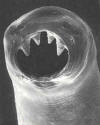 |
Ancylostoma duodenale
The teeth-like plates that are used to |
|
Female on left, male on right. |
 |
Hookworm
Rev.05/28/2025
Phylum: Nematoda
Class: Chromadorea
Order: Rhabditida
Family: Ancylostomatidae
 |
Ancylostoma duodenale
The teeth-like plates that are used to |
|
Female on left, male on right. |
 |
Oriental, Neotropical, Australian: Warm, temperate climates where there is adequate moisture.
Cost of treatment to kill the parasite; loss of productivity.
Human.
Usually found in unsanitary, warm, and moist conditions which favor the development of eggs and infection of hosts.
Rhabditiform larval stages feed on bacteria associated with organic matter.
Adult stage feeds on blood and tissue from the intestinal lining of the host.
Parasites draw mucus into their buccal cavity and suck the blood and tissue. The action of
digestive juices and the shearing of teeth form a bolus of tissue that is separated from the host gut and
ingested.
Host blood is drawn almost continuously into the intestine and passed out
through the anus. Blood plasma and corpuscles undergo at least partial digestion in the nematode.
Hookworms
consume up to 1 ml blood per individual per day.
Parasites are dioecious, with male and female organs in separate individuals.
Following copulation, female lays her eggs in the hosts intestine. Eggs are passed out in the host feces.
Usual daily output of eggs for a single female hookworm is between 10,000 and 30,000 eggs.
In favorable conditions of moisture, temperature, and oxygen, eggs develop in the soil and hatch when they reach maturity. They release a rhabditiform larva which feeds for a short time and molts twice before becoming an infective filariform larva.
 |
Filariform larvae (infective stage) of hookworm. |
Larva enters the host either by being swallowed or by burrowing into the skin through hair follicles.
When it reaches the small intestine of the host, the larva molts a fourth and final time and develops to maturity.
Infection by a hookworm usually results in bloody diarrhea and anemia.
Hookworm infections undermine the health of the host, causing stunting of growth and general laziness. Often accompanied by acute mental distress.
Trager, William. 1986. Living Together: The Biology of Animal Parasitism. Rockefeller University, NYC. <BR>
Smyth, J.D. 1962. Introduction to Animal Parasitology. English Universities Press Ltd., London. <BR>
Noble, Elmer R. and Glenn A. Noble. 1982. Parasitology: The Biology of Animal Parasites. Lea & Febiger, Philadelphia. <BR>
Olsen, O. Wilford. 1974. Animal Parasites: Their Life Cycles and Ecology. University Park Press. Baltimore.
Want more information about nematodes? Go to Nemaplex Main Menu.